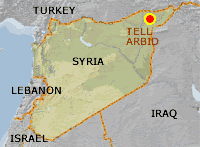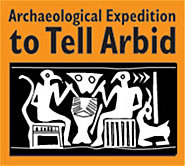ABOUT THE SITE
Tell Arbid is an archaeological site in North Mesopotamia. It covers the remains of an ancient city, a prosperous urban centre from the IIIrd millennium BC. Inhabited almost continuously through the entire Bronze Age and partly in the Iron Age, the site became a part of the Mitanni and Neo-Babylonian Empires. By the end of its existence, ancient Tell Arbid - already a rural settlement - was inhabited by the Hellenistic people.
The results of the excavations are presented by sectors, in stratigraphical order, from the latest to the earliest layers.
Localization
Tell Arbid is located in north-eastern Syria in the very heart of the Khabur Basin, some 45 km south of the modern town of Qamishliye and approximately 50 km to the north-northeast of Hassake. The sites of Tell Mozan, Tell Barri and Chagar Bazar are situated in the closest vicinity of Arbid. The contemporary name “Arbid” is an Arabic word for a black snake, but the ancient name of the town is still unknown.
It is a large site, with total surface exceeding 38 ha and rising over 30 m above the present surface. It consists of a "citadel", or a main tell, a lower town, and at least four secondary small mounds on the outskirts of the site.
History of research

Mallowan 1937, Tag. 20,
Fig. 8, no.1
The site was the object of archaeological investigations already in the 1930s, when sir Max Mallowan surveyed a few mounds in this region. He dug eight test trenches here before concentrating his efforts on Chagar Bazar and Tell Brak. During his explorations, Mallowan uncovered a richly furnished Early Dynastic chamber grave and dwelling quarters of the IIIrd and IInd millennium. In the time span of sixty years that have passed since the time of his investigations, the local inhabitants of Tell Arbid have repeatedly found valuable artefacts, most of which unfortunately entered the private market of antiquities. Mallowan’s excavations were followed by further surveys, including one by Dr. Bertille Lyonnet.
In the summer of 1996, joint Polish-Syrian archaeological expedition was established by an agreement between the Syrian Directorate-General of Antiquities and Museums and the University of Warsaw represented by the Polish Centre of Mediterranean Archaeology. Until 2007, the research was conducted by Prof. Piotr Bieliński from the University of Warsaw, the director of the PCMA and Dr. Ahmad Serriyeh from Damascus University. In 2008-2009 the Syrian co-director was Mr. Jovan Qassem of the Regional Department of Antiquities in Hassake.
In 2000 an Austro-American Mission headed by Prof. Gebhard Seltz from the Oriental Institute of Vienna University and David Nelson Gimbel from Archeos Inc. joined the team for one season to excavate the northern slope of the main tell (see: Web Publications).
A cooperation with a Czech Mission of the Brno Masaryk University headed by Dr. Inna Mateiciucová was established in 2004, in order to survey an area around the tell and explore a small Halaf period tell - Tell Arbid Abyad - in the vicinity of Tell Arbid.
In 2008 Dr. Rafał Koliński from the Institute of Prehistory, Adam Mickiewicz University in Poznań started investigations of Post-Akkadian remains in sector P (formerly called SR) within a three-year project "Collapse, regress or progress. The settlement and cultural landscape of the Syrian Jezirah at the end of the Early Bronze Age" (see: Web Publications).
Acknowledgements
The mission has profited from the generous help and constant support of Syrian Directorate-General of Antiquities and Museums in Damascus as well as from that of the Regional Department of Antiquities in Hassake, for which we are very grateful.
The mission would like to thank PKN ORLEN for its generous financial support which allowed for the purchase of a Trimble M3 DR Total Station.
 top
top



